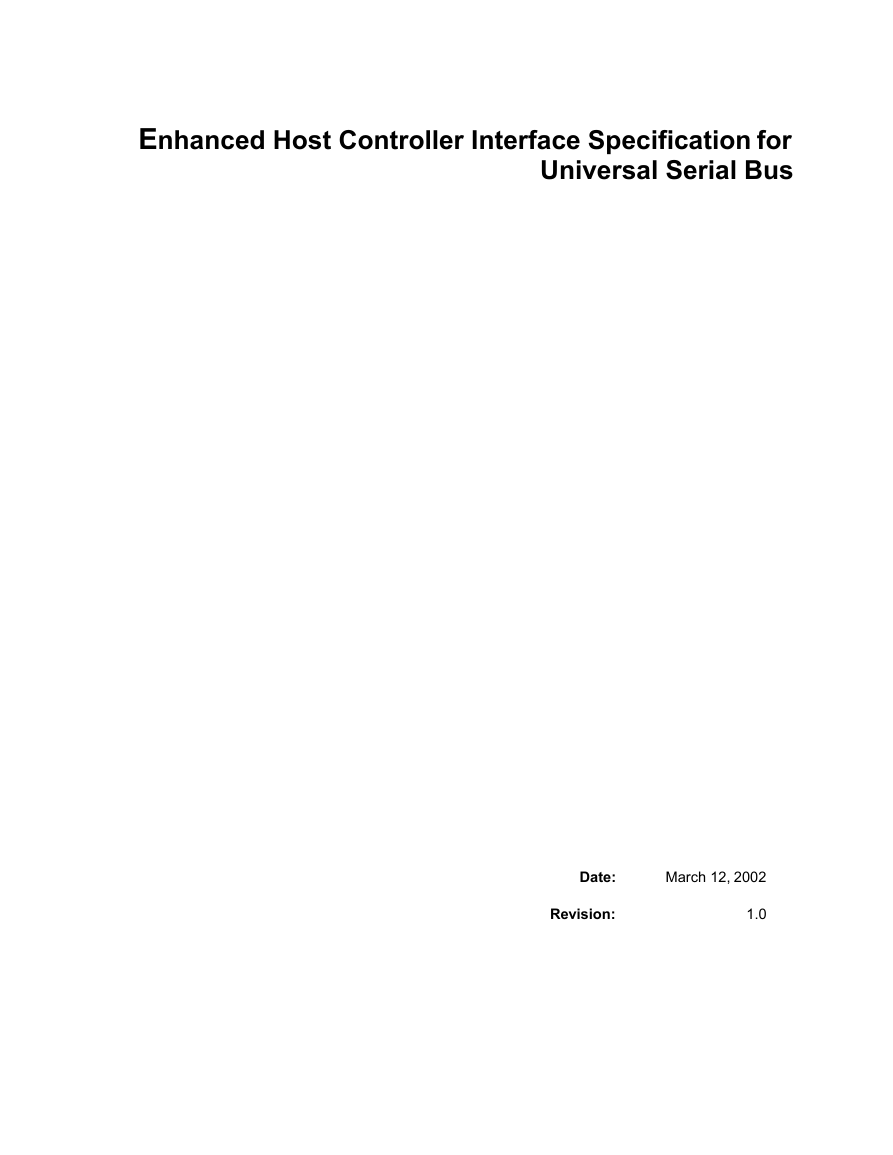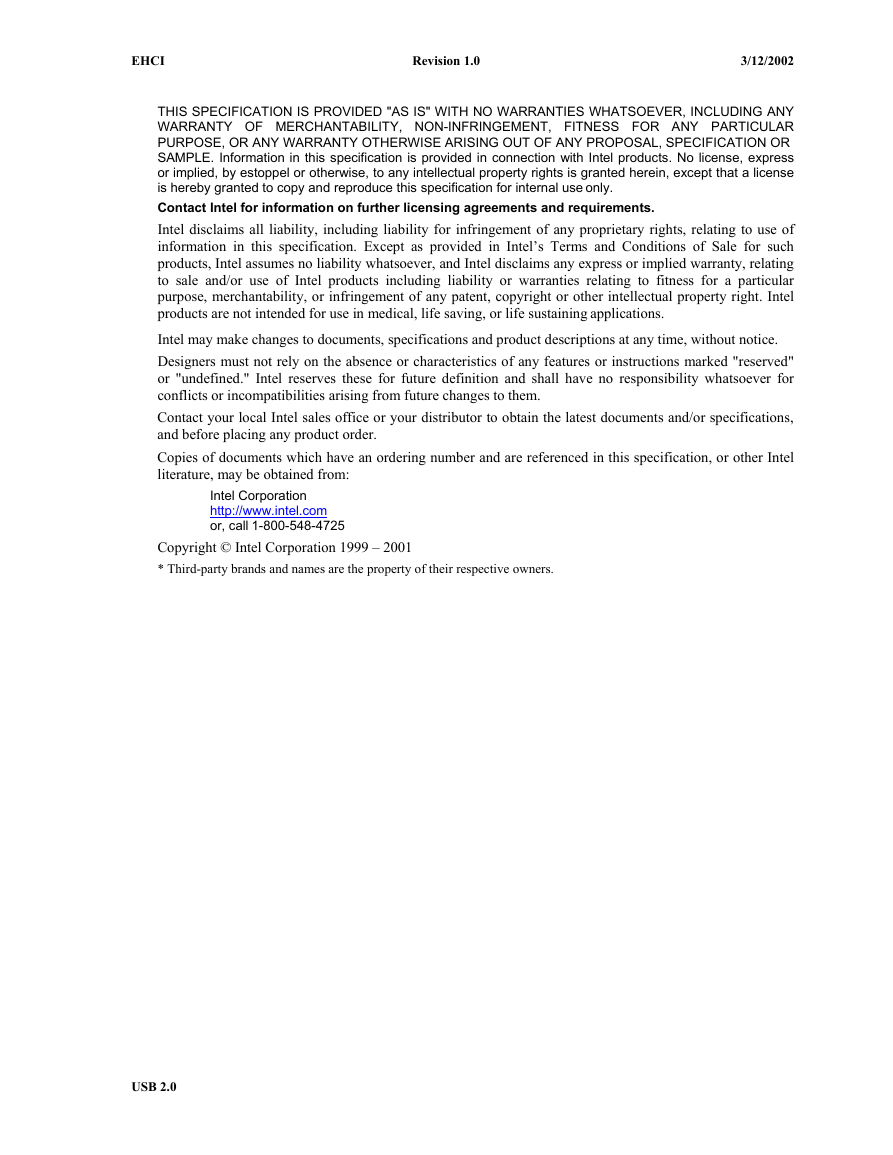Revision History
1. Introduction
1.1 EHCI Product Compliance
1.2 Architectural Overview
Figure 1-1. Universal Serial Bus, Revision 2.0 System Block Diagram
Figure 1-2. USB 2.0 Host Controller
1.2.1 Interface Architecture
Figure 1-3. General Architecture of Enhanced Host Controller Interface
1.2.2 EHCI Schedule Data Structures
1.2.3 Root Hub Emulation
2. Register Interface
Table 2-1. Enhanced Interface Register Sets
2.1 PCI Configuration Registers (USB)
Table 2-2. PCI Configuration Space Registers
2.1.1 PWRMGT PCI Power Management Interface
2.1.2 CLASSC CLASS CODE REGISTER
2.1.3 USBBASE Register Space Base Address Register
2.1.4 SBRN Serial Bus Release Number Register
2.1.5 Frame Length Adjustment Register (FLADJ)
2.1.6 Port Wake Capability Register (PORTWAKECAP)
2.1.7 USBLEGSUP USB Legacy Support Extended Capability
Table 2–3. USBLEGSUP USB Legacy Support Extended Capability
2.1.8 USBLEGCTLSTS USB Legacy Support Control/Status
Table 2–4. USBLEGCTLSTS USB Legacy Support Control/Status
2.2 Host Controller Capability Registers
Table 2-5. Enhanced Host Controller Capability Registers
2.2.1 CAPLENGTH Capability Registers Length
2.2.2 HCIVERSION Host Controller Interface Version Number
2.2.3 HCSPARAMS Structural Parameters
Table 2-6.HCSPARAMS Host Controller Structural Parameters
2.2.4 HCCPARAMS Capability Parameters
Table 2-7. HCCPARAMSHost Controller Capability Parameters
2.2.5 HCSP-PORTROUTE Companion Port Route Description
2.3 Host Controller Operational Registers
Table 2-8. Host Controller Operational Registers
2.3.1 USBCMD USB Command Register
Table 2-9. USBCMD – USB Command Register Bit Definitions
2.3.2 USBSTS USB Status Register
Table 2-10. USBSTS USB Status Register Bit Definitions
2.3.3 USBINTR USB Interrupt Enable Register
Table 2-11. USBINTR - USB Interrupt Enable Register
2.3.4 FRINDEX Frame Index Register
Table 2-12. FRINDEX Frame Index Register
2.3.5 CTRLDSSEGMENT Control Data Structure Segment Register
2.3.6 PERIODICLISTBASE Periodic Frame List Base Address Register
Table 2-13. PERIODICLISTBASE Periodic Frame List Base Address Register
2.3.7 ASYNCLISTADDR Current Asynchronous List Address Register
Table 2-14. ASYNCLISTADDR Current Asynchronous List Address Register
2.3.8 CONFIGFLAG Configure Flag Register
Table 2-15. CONFIGFLAG Configure Flag Register Bit Definitions
2.3.9 PORTSC Port Status and Control Register
Table 2-16. PORTSC Port Status and Control
3. Data Structures
3.1 Periodic Frame List
Figure 3-1. Periodic Schedule Organization
Figure 3-2. Format of Frame List Element Pointer
Table 3-1. Typ Field Value Definitions
3.2 Asynchronous List Queue Head Pointer
Figure 3-3. Asynchronous Schedule Organization
3.3 Isochronous (High-Speed) Transfer Descriptor (iTD)
Figure 3-4. Isochronous Transaction Descriptor (iTD)
3.3.1 Next Link Pointer
Table 3-2. Next Schedule Element Pointer
3.3.2 iTD Transaction Status and Control List
Table 3-3. iTD Transaction Status and Control
3.3.3 iTD Buffer Page Pointer List (Plus)
Table 3-4. iTD Buffer Pointer Page 0 (Plus)
3.4 Split Transaction Isochronous Transfer Descriptor (siTD)
Figure 3-5. Split-transaction Isochronous Transaction Descriptor (siTD)
3.4.1 Next Link Pointer
Table 3-8. Next Link Pointer
3.4.2 siTD Endpoint Capabilities/Characteristics
Table 3-9. Endpoint and Transaction Translator Characteristics
3.4.3 siTD Transfer State
Table 3-11. siTD Transfer Status and Control
3.4.4 siTD Buffer Pointer List (plus)
Table 3-12. Buffer Page Pointer List (plus)
3.4.5 siTD Back Link Pointer
Table 3-13. siTD Back Link Pointer
3.5 Queue Element Transfer Descriptor (qTD)
Figure 3-6. Queue Element Transfer Descriptor Block Diagram
3.5.1 Next qTD Pointer
Table 3-14. qTD Next Element Transfer Pointer (DWord 0)
3.5.2 Alternate Next qTD Pointer
Table 3-15. qTD Alternate Next Element Transfer Pointer (DWord 1)
3.5.3 qTD Token
Table 3-16. qTD Token (DWord 2)
3.5.4 qTD Buffer Page Pointer List
Table 3-17. qTD Buffer Pointer(s) (DWords 3-7)
3.6 Queue Head
Figure 3-7. Queue Head Structure Layout
3.6.1 Queue Head Horizontal Link Pointer
Table 3-18. Queue Head DWord 0
Table 3-19. Endpoint Characteristics: Queue Head DWord 1
Table 3-21. Current qTD Link Pointer
Table 3-22. Host-Controller Rules for Bits in Overlay (DWords 5, 6, 8 and 9)
3.7 Periodic Frame Span Traversal Node (FSTN)
Figure 3-8. Frame Span Traversal Node Structure Layout
3.7.1 FSTN Normal Path Pointer
3.7.2 FSTN Back Path Link Pointer
4. Operational Model
4.1 Host Controller Initialization
Table 4–1. Default Values of Operational Register Space
4.2 Port Routing and Control
Figure 4-1. Example USB 2.0 Host Controller Port Routing Block Diagram
Table 4–2. Default Port Routing Depending on EHCI HC CF Bit
4.2.2 Port Routing Control via PortOwner and Disconnect Event
4.2.3 Example Port Routing State Machine
Figure 4-2. Port Owner Handoff State Machine
4.2.3.2 Companion HC Owner
4.2.4 Port Power
Table 4–3. Port Power Enable Control Rules
4.2.5 Port Reporting Over-Current
4.3 Suspend/Resume
4.3.1 Port Suspend/Resume
Table 4–4. Behavior During Wake-up Events
4.4 Schedule Traversal Rules
Figure 4-3. Derivation of Pointer into Frame List Array
Figure 4-4. General Format of Asynchronous Schedule List
4.4.1 Example - Preserving Micro-Frame Integrity
4.4.1.1 Transaction Fit - A Best-Fit Approximation Algorithm
Figure 4-5. Best Fit Approximation
Table 4–5. Example Worse-case Transaction Timing Components
4.5 Periodic Schedule Frame Boundaries vs Bus Frame Boundaries
Figure 4-6. Frame Boundary Relationship between HS bus and FS/LS Bus
Figure 4-7. Relationship of Periodic Schedule Frame Boundaries to Bus Frame Boundaries
Table 4–6. Operation of FRINDEX and SOFV (SOF Value Register)
4.6 Periodic Schedule
Figure 4-8. Example Periodic Schedule
4.7 Managing Isochronous Transfers Using iTDs
4.7.1 Host Controller Operational Model for iTDs
4.7.2 Software Operational Model for iTDs
…
…
Figure 4-9. Example Association of iTDs to Client Request Buffer
4.8 Asynchronous Schedule
4.8.1 Adding Queue Heads to Asynchronous Schedule
4.8.2 Removing Queue Heads from Asynchronous Schedule
Figure 4-10. Generic Queue Head Unlink Scenario
4.8.3 Empty Asynchronous Schedule Detection
Figure 4-11. Asynchronous Schedule List w/Annotation to Mark Head of List
4.8.4 Restarting Asynchronous Schedule Before EOF
Figure 4-12. Example State Machine for Managing Asynchronous Schedule Traversal
Table 4–7. Asynchronous Schedule SM Transition Actions
4.8.4.1.3 Async Sched Sleeping
Table 4–8. Typical Low-/Full-speed Transaction Times
4.8.6 Reclamation Status Bit (USBSTS Register)
4.9 Operational Model for Nak Counter
Table 4–9. NakCnt Field Adjustment Rules
4.9.1 Nak Count Reload Control
Figure 4-13. Example HC State Machine for Controlling Nak Counter Reloads
4.9.1.2 Do Reload
4.9.1.3 Wait for Start Event
4.10 Managing Control/Bulk/Interrupt Transfers via Queue Heads
Figure 4-14. Host Controller Queue Head Traversal State Machine
4.10.1 Fetch Queue Head
4.10.2 Advance Queue
4.10.3 Execute Transaction
Interrupt Transfer Pre-condition Criteria
Asynchronous Transfer Pre-operations and Pre-condition Criteria
Transfer Type Independent Pre-operations
4.10.3.1 Halting a Queue Head
4.10.3.2 Asynchronous Schedule Park Mode
Table 4–10. Actions for Park Mode, based on Endpoint Response and Residual Transfer State
4.10.4 Write Back qTD
4.10.5 Follow Queue Head Horizontal Pointer
4.10.6 Buffer Pointer List Use for Data Streaming with qTDs
Figure 4-15. Example Mapping of qTD Buffer Pointers to Buffer Pages
4.10.7 Adding Interrupt Queue Heads to the Periodic Schedule
Table 4–11. Example Periodic Reference Patterns for Interrupt Transfers with 2ms Poll Rate
4.10.8 Managing Transfer Complete Interrupts from Queue Heads
4.11 Ping Control
Table 4–12. Ping Control State Transition Table
4.12 Split Transactions
4.12.1 Split Transactions for Asynchronous Transfers
Figure 4-16. Host Controller Asynchronous Schedule Split-Transaction State Machine
4.12.1.2 Asynchronous - Do Complete Split
4.12.2 Split Transaction Interrupt
4.12.2.1 Split Transaction Scheduling Mechanisms for Interrupt
Figure 4-17. Split Transaction, Interrupt Scheduling Boundary Conditions
Figure 4-18. General Structure of EHCI Periodic Schedule Utilizing Interrupt Spreading
4.12.2.2 Host Controller Operational Model for FSTNs
4.12.2.2.1 Host Controller Operational Model for FSTNs
Figure 4-19. Example Host Controller Traversal of Recovery Path via FSTNs
4.12.2.2.2 Software Operational Model for FSTNs
4.12.2.3 Tracking Split Transaction Progress for Interrupt Transfers
4.12.2.4 Split Transaction Execution State Machine for Interrupt
Figure 4-20. Split Transaction State Machine for Interrupt
4.12.2.4.2 Periodic Interrupt - Do Complete Split
Table 4–13. Interrupt IN/OUT Do Complete Split State Execution Criteria
4.12.2.5 Rebalancing the Periodic Schedule
4.12.3 Split Transaction Isochronous
4.12.3.1 Split Transaction Scheduling Mechanisms for Isochronous
Figure 4-21. Split Transaction, Isochronous Scheduling Boundary Conditions
Figure 4-22. siTD Scheduling Boundary Examples
4.12.3.2 Tracking Split Transaction Progress for Isochronous Transfers
4.12.3.3 Split Transaction Execution State Machine for Isochronous
Figure 4-23. Split Transaction State Machine for Isochronous
Table 4–14. Initial Conditions for OUT siTD's TP and T-count Fields
Table 4–15. Transaction Position (TP)/Transaction Count (T-Count) Transition Table
4.12.3.3.2.1 Complete-Split for Scheduling Boundary Cases 2a, 2b
Table 4–16. Summary siTD Split Transaction State
4.12.3.4 Split Transaction for Isochronous - Processing Examples
Table 4–17. Example Case 2a - Software Scheduling siTDs for an IN Endpoint
4.13 Host Controller Pause
4.14 Port Test Modes
4.15 Interrupts
4.15.1 Transfer/Transaction Based Interrupts
4.15.1.1 Transaction Error
Table 4–18 Summary of Transaction Errors
4.15.1.1.2 Data Buffer Error
4.15.1.2 USB Interrupt (Interrupt on Completion (IOC))
4.15.1.3 Short Packet
4.15.2 Host Controller Event Interrupts
4.15.2.1 Port Change Events
4.15.2.2 Frame List Rollover
4.15.2.3 Interrupt on Async Advance
4.15.2.4 Host System Error
Table 4–19. Summary Behavior of EHCI Host Controller on Host System Errors
5. EHCI Extended Capabilities
Table 5–1. Format of EHCI Extended Capability Pointer Register
Table 5–2. EHCI Extended Capability Codes
5.1 EHCI Extended Capability: Pre-OS to OS Handoff Synchronization
Figure 5-1. BIOS Ownership State Machine
Figure 5-2. OS Ownership State Machine
Appendix A. EHCI PCI Power Management Interface
Table A-3. EHCI Support for Power Management States
A.1.2 Power State Definitions
Table A-4. EHCI Power State Summary
Appendix B. EHCI 64-Bit Data Structures
Figure B-1. 64-bit Isochronous Transaction Descriptor (iTD-64)
Figure B-2. 64-bit Split Transaction Isochronous Transaction Descriptor (siTD-64)
Figure B-3. 64-bit Queue Element Transaction Descriptor (qTD-64)
Figure B-4. 64-bit Queue Head Descriptor (QH-64)
Appendix C. Debug Port
C.1 Locating the Debug Port
Figure C-1. Debug Port Capability Register Layout
Table C-3. DEBUG_PORT
Figure C-2 Debug Port Capability Register
C.3 USB2 Debug Port Register Interface
Table C-4. Debug Port Control Register
Table C-5. Control/Status Register Bits
Table C-6. USB PIDs Register
Table C-7. Data Buffer
Table C-8. Device Address Register
Table C-9. Summary of Port Behavior vs. Register Settings
C.4.3 Debug Software Startup
C.4.3.1 Startup before System Host Controller Driver
C.4.3.2 Startup after System Host Controller Driver
C.4.4 Finding the Debug Peripheral
Appendix D. High Bandwidth Isochronous Rules
Table D-1. High-Bandwidth Behavior for OUT Transactions
Table D-2. High-Bandwidth Behavior for IN Transactions
















 2023年江西萍乡中考道德与法治真题及答案.doc
2023年江西萍乡中考道德与法治真题及答案.doc 2012年重庆南川中考生物真题及答案.doc
2012年重庆南川中考生物真题及答案.doc 2013年江西师范大学地理学综合及文艺理论基础考研真题.doc
2013年江西师范大学地理学综合及文艺理论基础考研真题.doc 2020年四川甘孜小升初语文真题及答案I卷.doc
2020年四川甘孜小升初语文真题及答案I卷.doc 2020年注册岩土工程师专业基础考试真题及答案.doc
2020年注册岩土工程师专业基础考试真题及答案.doc 2023-2024学年福建省厦门市九年级上学期数学月考试题及答案.doc
2023-2024学年福建省厦门市九年级上学期数学月考试题及答案.doc 2021-2022学年辽宁省沈阳市大东区九年级上学期语文期末试题及答案.doc
2021-2022学年辽宁省沈阳市大东区九年级上学期语文期末试题及答案.doc 2022-2023学年北京东城区初三第一学期物理期末试卷及答案.doc
2022-2023学年北京东城区初三第一学期物理期末试卷及答案.doc 2018上半年江西教师资格初中地理学科知识与教学能力真题及答案.doc
2018上半年江西教师资格初中地理学科知识与教学能力真题及答案.doc 2012年河北国家公务员申论考试真题及答案-省级.doc
2012年河北国家公务员申论考试真题及答案-省级.doc 2020-2021学年江苏省扬州市江都区邵樊片九年级上学期数学第一次质量检测试题及答案.doc
2020-2021学年江苏省扬州市江都区邵樊片九年级上学期数学第一次质量检测试题及答案.doc 2022下半年黑龙江教师资格证中学综合素质真题及答案.doc
2022下半年黑龙江教师资格证中学综合素质真题及答案.doc